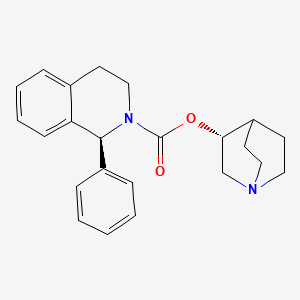CASRN: 242478-37-1

Drug Levels and Effects
Summary of Use during Lactation
Because there is no published experience with solifenacin during breastfeeding and it has a long half-life averaging 55 hours, an alternate drug may be preferred, especially while nursing a newborn or preterm infant. Long-term use of solifenacin might reduce milk production or milk letdown. During long-term use, observe the infant for signs of decreased milk production (e.g., insatiety, poor weight gain) and for anticholinergic symptoms (e.g., constipation, urinary retention, UTI, dry mouth).
Drug Levels
Maternal Levels. Relevant published information was not found as of the revision date.
Infant Levels. Relevant published information was not found as of the revision date.
Effects in Breastfed Infants
Relevant published information was not found as of the revision date.
Effects on Lactation and Breastmilk
Anticholinergics can inhibit lactation in animals, apparently by inhibiting growth hormone and oxytocin secretion.[1-5] Anticholinergic drugs can also reduce serum prolactin in nonnursing women.[6] The prolactin level in a mother with established lactation may not affect her ability to breastfeed.
References
- 1.
- Aaron DK, Ely DG, Deweese WP, et al. Reducing milk production in ewes at weaning using restricted feeding and methscopolamine bromide. J Anim Sci. 1997;75:1434–42. [PubMed: 9250502]
- 2.
- Powell MR, Keisler DH. A potential strategy for decreasing milk production in the ewe at weaning using a growth hormone release blocker. J Anim Sci. 1995;73:1901–5. [PubMed: 7592071]
- 3.
- Daniel JA, Thomas MG, Powell MR, et al. Methscopolamine bromide blocks hypothalmic-stimulated release of growth hormone in ewes. J Anim Sci. 1997;75:1359–62. [PubMed: 9159285]
- 4.
- Bizzarro A, Iannucci F, Tolino A, et al. Inhibiting effect of atropine on prolactin blood levels after stimulation with TRH. Clin Exp Obstet Gynecol. 1980;7:108–11. [PubMed: 6788407]
- 5.
- Svennersten K, Nelson L, Juvnäs-Moberg K. Atropinization decreases oxytocin secretion in dairy cows. Acta Physiol Scand. 1992;145:193–4. [PubMed: 1636447]
- 6.
- Masala A, Alagna S, Devilla L, et al. Muscarinic receptor blockade by pirenzepine: Effect on prolactin secretion in man. J Endocrinol Invest. 1982;5:53–5. [PubMed: 6808052]
Substance Identification
Substance Name
Solifenacin
CAS Registry Number
242478-37-1
Drug Class
Breast Feeding
Lactation
Muscarinic Antagonists
Parasympatholytics
Disclaimer: Information presented in this database is not meant as a substitute for professional judgment. You should consult your healthcare provider for breastfeeding advice related to your particular situation. The U.S. government does not warrant or assume any liability or responsibility for the accuracy or completeness of the information on this Site.
Publication Details
Publication History
Last Revision: April 19, 2021.
Copyright
Attribution Statement: LactMed is a registered trademark of the U.S. Department of Health and Human Services.
Publisher
National Institute of Child Health and Human Development, Bethesda (MD)
NLM Citation
Drugs and Lactation Database (LactMed®) [Internet]. Bethesda (MD): National Institute of Child Health and Human Development; 2006-. Solifenacin. [Updated 2021 Apr 19].